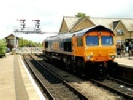Archive Section




By Peter Lindop.
From a 1999 Newsletter
Details the history of Maltease Railways and what what remains can be seen today
While on a recent holiday to the island of Malta I did some exploring of the old railway. The contrast in what I found was amazing; in some places it was obvious, while in others there was no trace. Perhaps the lack of evidence is not surprising, the line closed way back in 1931!
The first plan was laid before the Maltese Government in 1870; the island being one of the last countries in Europe without a railway. After the usual change of plans; systems; people and companies, it was not until 28th February 1883 that the line finally opened. It ran from the capital, Valletta, to Notabile station, on the outskirts of Rabat/Mdina The line was a metre gauge (3ft 3 3/8in), single throughout (except at stations) and worked by four 0-
Valletta station building was at street level by the main City gate, the two platforms were mainly in a tunnel 35ft below. The lines crossed the main City ditch on a bridge (Porta Reale) before going onto a single-
The main headquarters and engineering workshops were set up at Harnrun (1 mile, 635 yards from Valletta). This station was considered as important as the termini. Birkirkara (nearly 3 miles away) marked the end of the profitable section; the line now crossing open countryside. The original terminus at Notable was reached 6 miles 600 yards from Valletta. The station was the subject of much public complaining, being in a cutting and then up a steep rough hill to reach the old city of Rabat.
In 1900, an extension opened to Museum station. This involved a 770-
The original private company did not run the railway very well, troubled by financial, legal and technical problems. Locomotive failures meant a single train service, then there was a shut down in spring, 1889. The government sued for breach of contract, and then closed the railway on 1 April 1890. The line reopened on 25 February 1892, having been taken over and run by the government to stop it being sold off. The railway's health began to flourish, with passengers returning. Improvements were made to stations; new locomotives and rolling stock bought; a large backlog of track maintenance tackled and the Museum extension opened. After World War 1, income began to suffer with competition from the electric tramway around Valletta (opened in 1905) and new road motor busses. The end finally came on 31 March 1931, although it outlasted the electric tramway, which had closed on 16 December 1929!
The technical school and workshop, started in 1895 at Harnrun, continued until 1950, offering probably the best engineering apprenticeship on the island.
The Railway Today:
Starting at Valletta, here is a brief description of what I found -
I did not have time to explore the middle section of the line, something for another visit!
The western end of the line seems to have disappeared into the farmland. Notabile station still survives, situated by a local road. While the cutting by the station has been filled in, a path leads down to the (fenced off) portal of the tunnel under Mdina. The other end of the 770-
I believe no items of rolling stock survive today.
The island is a wonderful place to visit; the railway remains are only one small distraction. While travelling around, don't miss out on a ride on the buses (some ex London Transport) there is a different experience on every journey!